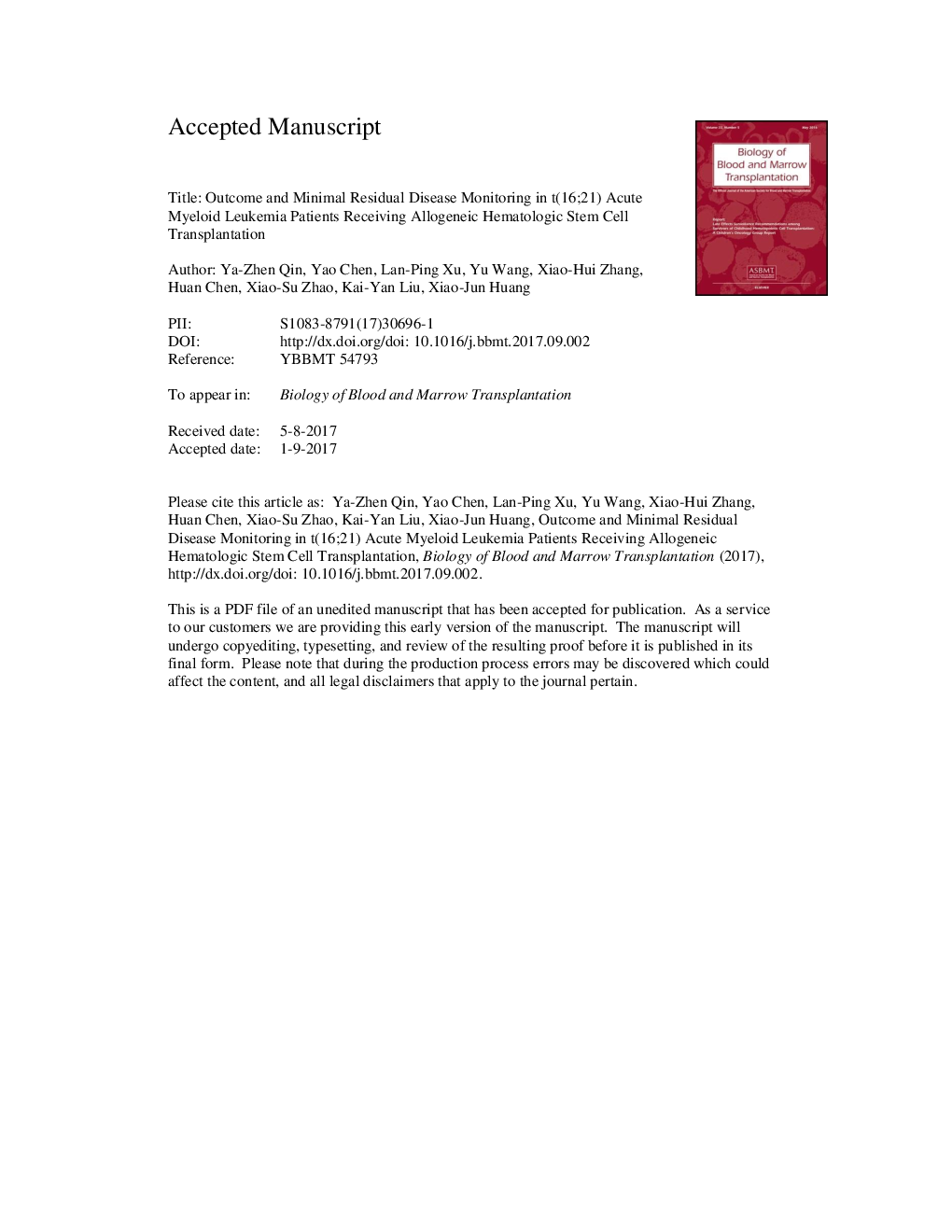| کد مقاله | کد نشریه | سال انتشار | مقاله انگلیسی | نسخه تمام متن |
|---|---|---|---|---|
| 8430610 | 1546233 | 2018 | 31 صفحه PDF | دانلود رایگان |
عنوان انگلیسی مقاله ISI
Outcome and Minimal Residual Disease Monitoring in Patients with t(16;21) Acute Myelogenous Leukemia Undergoing Allogeneic Hematopoietic Stem Cell Transplantation
ترجمه فارسی عنوان
نتیجه گیری و مانیتورینگ بیماری های باقی مانده در بیماران مبتلا به تیروئید (16، 21) لوسمی حاد میلوئیدی تحت پیوند سلول های هماتوپوئیدی آلوژنیک
دانلود مقاله + سفارش ترجمه
دانلود مقاله ISI انگلیسی
رایگان برای ایرانیان
کلمات کلیدی
موضوعات مرتبط
علوم زیستی و بیوفناوری
بیوشیمی، ژنتیک و زیست شناسی مولکولی
تحقیقات سرطان
چکیده انگلیسی
Patients with t(16;21) acute myelogenous leukemia (AML) who receive chemotherapy have poor outcomes. The treatment efficacy of allogeneic hematopoietic stem cell transplantation (allo-HSCT) must be identified, and the usefulness of minimal residual disease (MRD) monitoring requires evaluation. Fourteen consecutive patients with t(16;21) AML undergoing allo-HSCT at our institution were included in this study. Translocation liposarcoma- ETS-related gene (TLS-ERG) transcript levels were serially monitored for a median of 15 months (range, 3-51 months) after allo-HSCT. Eight patients relapsed, 7 patients died from relapse-related causes, and 1 patient died from a non-relapse-related cause. The 2-year cumulative incidence rates of relapse, disease-free survival, and overall survival after HSCT were 66.2%, 30.8%, and 46.2%, respectively. Of the 3 patients who received an HLA-matched sibling transplant, 2 relapsed, and 1 (33.3%) was in hematologic complete remission (CR) but died of nonrelapse mortality, whereas 5 of 11 patients (45.5%) who received haploidentical transplantation were in CR and were alive. Two of 6 patients with undetectable TLS-ERG at the time of allo-HSCT relapsed, at 14 and 15 months, and 3 of 4 PCR-positive patients relapsed, at a median of 10 months after HSCT. Four patients with continually low post-HSCT TLS-ERG levels (mostly <.01%) remained alive and in CR. The TLS-ERG levels of all 8 patients who relapsed were significantly increased before the relapse, exceeding 1.0% in all 7 patients who experienced hematologic relapse. In total, 7 patients received modified donor lymphocyte infusion (DLI), and 1 patient received IFN-α. All 7 patients with a TLS-ERG level >5.0% at the time of intervention experienced an increase or a brief decrease in TLS-ERG level, followed by an increase, and 6 relapsed, whereas the TLS-ERG level of 1 patient with a TLS-ERG level <1.0% at intervention decreased to undetectable. Therefore, t(16;21) AML is an indication for allo-HSCT. Among the HSCT recipients, 30.8% responded to treatment with CR. TLS-ERG transcript levels reflect MRD and might predict relapse and guide effective intervention.
ناشر
Database: Elsevier - ScienceDirect (ساینس دایرکت)
Journal: Biology of Blood and Marrow Transplantation - Volume 24, Issue 1, January 2018, Pages 163-168
Journal: Biology of Blood and Marrow Transplantation - Volume 24, Issue 1, January 2018, Pages 163-168
نویسندگان
Ya-Zhen Qin, Yao Chen, Lan-Ping Xu, Yu Wang, Xiao-Hui Zhang, Huan Chen, Xiao-Su Zhao, Kai-Yan Liu, Xiao-Jun Huang,
